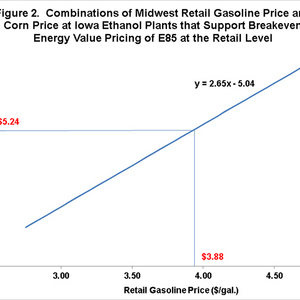Lower corn prices could boost E85 use, infrastructure still short

FarmDocDaily
June 6, 2013
BY Susanne Retka Schill
Starting with the question, “What price of corn will make E85 competitive?” University of Illinois economists Scott Irwin and Darrel Good examined the breakeven prices of E85, ethanol and corn.
While $7 corn at current retail gasoline prices doesn’t favor E85 expansion, if the 2013 corn crop comes through, they write, “it is feasible that corn prices could decline below the breakeven price for E85 if retail gasoline prices remain near current levels. If so, expanding E85 consumption could help expand the ethanol blend wall and add to the demand for corn to be processed into ethanol.”
The two agriculture economists have been publishing an ongoing series of FarmDocDaily posts examining multiple issues around the renewable fuels standard. In this post they look closely at the retail price of gasoline, price variations and the relative value of E85. “While the logic for an energy breakeven level of E85 pricing is straightforward, there is uncertainty about whether consumers will in fact require a higher or lower discount to incentivize greater use of E85,” they add.
The economic model factors in the wholesale-retail spread, the wholesale price of ethanol at Chicago need for a breakeven wholesale price of E85, plus the breakeven price of corn at an ethanol plant. “For a change of 10 cents per gallon in the retail price of gasoline, then, the breakeven price of corn changes by 26.5 cents per bushel.” On June 3, the average retail price of gasoline on June 3 was $3.88 per gallon, implying a breakeven price of corn of $5.24 per bushel. “In other words, if the price of corn is $5.24 and the pump price of gasoline is $3.88 then E85 can be priced at its energy equivalent value and everyone from ethanol producers to gasoline consumers just breaks even.”
Advertisement
Advertisement
While a drop in corn prices from a good corn crop would favor more E85 consumption, the economists add that the size of the E85 market could still be constrained. This is due to the limited number and lack of concentration of refueling stations, even though some 11 million vehicles in the U.S. are flex-fuel. “It appears that increasing E85 consumption above 600 million gallons will require additional infrastructure investments. This will take time and likely limits the size of E85 use through at least 2014,” they conclude.
Advertisement
Advertisement
Related Stories
The U.S. exported 31,160.5 metric tons of biodiesel and biodiesel blends of B30 and greater in May, according to data released by the USDA Foreign Agricultural Service on July 3. Biodiesel imports were 2,226.2 metric tons for the month.
The USDA’s Risk Management Agency is implementing multiple changes to the Camelina pilot insurance program for the 2026 and succeeding crop years. The changes will expand coverage options and provide greater flexibility for producers.
EcoCeres Inc. has signed a multi-year agreement to supply British Airways with sustainable aviation fuel (SAF). The fuel will be produced from 100% waste-based biomass feedstock, such as used cooking oil (UCO).
CARB on June 27 announced amendments to the state’s LCFS regulations will take effect beginning on July 1. The amended regulations were approved by the agency in November 2024, but implementation was delayed due to regulatory clarity issues.
SAF Magazine and the Commercial Aviation Alternative Fuels Initiative announced the preliminary agenda for the North American SAF Conference and Expo, being held Sept. 22-24 at the Minneapolis Convention Center in Minneapolis, Minnesota.
Upcoming Events










